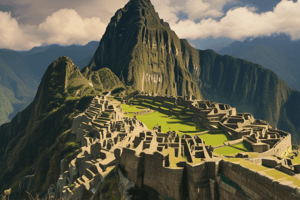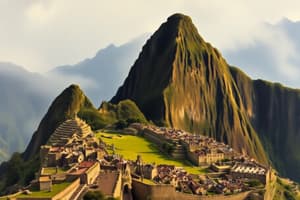Podcast
Questions and Answers
What is one of the mysteries surrounding Machu Picchu's purpose?
What is one of the mysteries surrounding Machu Picchu's purpose?
- The absence of evidence makes its exact purpose unclear. (correct)
- There are extensive written records detailing its function.
- It served solely as a military outpost.
- It was simply a resort for Inca nobility.
What significant achievement did the Inca Empire accomplish in terms of infrastructure?
What significant achievement did the Inca Empire accomplish in terms of infrastructure?
- They constructed bridges made entirely of wood.
- They built a single road connecting all major cities.
- They developed an extensive road network over 10,000 miles. (correct)
- They created an underground subway system.
Who is credited with the discovery of Machu Picchu in 1911?
Who is credited with the discovery of Machu Picchu in 1911?
- Hiram Bingham (correct)
- John Verano
- Pachacuti
- Francisco Pizarro
What did John Verano's study reveal about the skeletal remains at Machu Picchu?
What did John Verano's study reveal about the skeletal remains at Machu Picchu?
What material was predominantly used in the construction of Machu Picchu?
What material was predominantly used in the construction of Machu Picchu?
What was significant about Machu Picchu's location?
What was significant about Machu Picchu's location?
Under whose reign was Machu Picchu built?
Under whose reign was Machu Picchu built?
What factor contributed to the prevention of erosion at Machu Picchu?
What factor contributed to the prevention of erosion at Machu Picchu?
What was the primary purpose of Machu Picchu for the Inca Emperor Pachacuti?
What was the primary purpose of Machu Picchu for the Inca Emperor Pachacuti?
Which of the following factors contributed to the abandonment of Machu Picchu?
Which of the following factors contributed to the abandonment of Machu Picchu?
How did the Inca view the natural landscape around Machu Picchu?
How did the Inca view the natural landscape around Machu Picchu?
Which engineering techniques did the Inca use in constructing structures like Machu Picchu?
Which engineering techniques did the Inca use in constructing structures like Machu Picchu?
What can be inferred about the skeletons found at Machu Picchu?
What can be inferred about the skeletons found at Machu Picchu?
What role did mummies play in Inca society?
What role did mummies play in Inca society?
What message did the strategic location of Machu Picchu communicate?
What message did the strategic location of Machu Picchu communicate?
What happened to Machu Picchu during the Spanish conquest of the Inca Empire?
What happened to Machu Picchu during the Spanish conquest of the Inca Empire?
Study Notes
Machu Picchu: A City of Mysteries
- Machu Picchu is a 15th century Inca mountain city located in the Peruvian Andes.
- The city is built on a narrow ridge at an altitude of approximately 8,000 feet.
- Machu Picchu was thought to be the lost city of Vilcabamba, a refuge for the last Inca emperor.
- The city boasts more than 200 structures, including homes, temples, fountains, and pools.
- The city's construction is remarkable, featuring intricately cut stones without the use of mortar.
- Machu Picchu's purpose remains a mystery, with no written records or carvings to explain its use.
The Inca Empire
- The Inca Empire flourished from the mid-1400s to the early 1600s.
- The Inca developed an impressive road network spanning over 10,000 miles.
- They were renowned for their engineering and construction skills, creating terraces, canals, and stone cities.
- The Inca Empire was conquered by Spanish conquistadors in the 1500s.
- The Inca's complex system of knotted strings called quipu provided a form of record-keeping but lacked written language.
Hiram Bingham and the Discovery
- Hiram Bingham discovered Machu Picchu on July 24, 1911.
- He initially believed the city to be Vilcabamba, the lost city of the Inca.
- Bingham's discovery was widely documented, and his narrative about the "Virgins of the Sun" gained popularity.
Challenging the Narrative
- Forensic anthropologist John Verano's study of the skeletal remains at Machu Picchu refuted Bingham's theory of the "Virgins of the Sun."
- The study found an almost equal distribution of male and female skeletons, discrediting the notion of a convent for virgins.
- The absence of Spanish desecration and the lack of evidence supporting the "Virgins of the Sun" theory further discredited Bingham's claim.
The Truth About Machu Picchu
- Machu Picchu is not Vilcabamba.
- The city was strategically located for its water source, granite supply, and access to farmland in nearby towns.
- The complex system of terraces and drainage channels served to stabilize the mountainside and prevent erosion.
- The city's construction required substantial underground work, with extensive foundations and drainage systems.
- Machu Picchu was likely used for both religious and military purposes.
The Construction of Machu Picchu
- The city was built by the Inca under the reign of Pachacuti, the first Inca emperor.
- The construction process was meticulous, involving the use of granite and skilled stone cutters.
- The Inca utilized a system of levers and wedges to raise and position the heavy stones.
- Machu Picchu is a testament to the Inca's engineering expertise and artistic ability.
The Inca and Their Legacy
- The Inca were skilled engineers, builders, and warriors who successfully conquered large regions.
- The empire's legacy is evident in the impressive remains of their cities and infrastructure.
- The Inca built Machu Picchu as a symbol of their power and mastery.
- The city's discovery and ongoing research contribute to our understanding of the Inca civilization.
Machu Picchu's Location
- Machu Picchu was built in a remote and challenging location, high in the Andes Mountains.
- The Inca believed in the sacredness of the landscape and worshipped the sun, mountains, and rivers as deities.
- The location of Machu Picchu, surrounded by sacred mountains and the Urubamba River, likely reflected this reverence for the natural environment.
Machu Picchu's Purpose
- Machu Picchu was a royal estate for the Inca Emperor Pachacuti.
- The site served as a peaceful retreat for the emperor and his court, where they could worship, relax, and enjoy themselves.
- Evidence suggests that Machu Picchu also played a role in warfare, serving as a symbol of Inca power and dominance.
- The site's strategic location, visible to those in the surrounding valley, conveyed a message of conquest and possession.
- Skeletons found at Machu Picchu indicate a diverse population, including royal servants, laborers, and possibly military personnel.
Machu Picchu's Abandonment
- The site was likely abandoned after the death of Pachacuti, due to factors such as the decline of his dynasty and the spread of smallpox.
- The Spanish conquest of the Inca Empire led to further instability and disintegration of the Inca political structure.
- The Spanish may have never learned about or found Machu Picchu, which helped preserve it from destruction.
- The lack of Spanish accounts or descriptions about the site also contributes to its intact state.
The Role of Inca Mummies
- Inca rulers, including Pachacuti, were mummified after death.
- Mummies were believed to continue to hold political and spiritual power and were involved in important rituals and ceremonies.
- The care and handling of mummies was entrusted to a group of family members known as the Panaka, who also controlled the royal estates.
- The descendants of Pachacuti likely lost focus on maintaining Machu Picchu after the death of their ancestor, resulting in its gradual abandonment.
Machu Picchu
- A 15th century Inca city located in the Peruvian Andes
- Built on a narrow ridge at an altitude of approximately 8,000 feet
- Features over 200 structures, including homes, temples, fountains, and pools
- Construction involved intricately cut stones without the use of mortar
- It's purpose remains a mystery.
The Inca
- Flourished from the mid-1400s to the early 1600s
- Developed an impressive road network spanning over 10,000 miles
- Renowned for engineering and construction skills
- Conquered by Spanish conquistadors in the 1500s
- Utilized quipu, a system of knotted strings for record-keeping, lacking written language.
Discovery and Narrative
- Hiram Bingham discovered Machu Picchu on July 24, 1911
- Initially believed it to be Vilcabamba, the lost city of the Inca
- Bingham's discovery was widely documented, popularizing his narrative about the "Virgins of the Sun."
Challenging the Narrative
- John Verano's study of skeletal remains refuted Bingham's theory of the "Virgins of the Sun."
- Found an almost equal distribution of male and female skeletons, discrediting the convent notion.
- The absence of Spanish desecration and lack of evidence further discredited Bingham's claim.
The Truth About Machu Picchu
- Located strategically for its water source, granite supply, and access to farmland
- Its complex system of terraces and drainage channels helped stabilize the mountainside and prevent erosion
- Construction involved extensive underground work, foundations, and drainage systems
- Was likely used for both religious and military purposes.
The Construction
- Built by the Inca under Pachacuti, the first Inca emperor
- Construction utilized granite and skilled stone cutters
- Inca used levers and wedges to raise and position heavy stones
- A testament to the Inca's engineering expertise and artistry.
Inca Legacy
- Skilled engineers, builders, and warriors who conquered large regions
- Empire's legacy is evident in their cities' remains and infrastructure
- Machu Picchu was built as a symbol of their power and mastery
- The city's ongoing research contributes to our understanding of the Inca civilization.
Location
- Built in a remote and challenging location high in the Andes Mountains
- Inca revered the landscape, worshipping the sun, mountains, and rivers as deities
- Location surrounded by sacred mountains and the Urubamba River likely reflected their reverence for nature.
Purpose
- A royal estate for the Inca Emperor Pachacuti
- Served as a peaceful retreat for the emperor and his court
- Evidence suggests a role in warfare, symbolizing Inca power and dominance
- Its strategic location conveyed a message of conquest and possession
- Skeletons indicate a diverse population including royal servants, laborers, and possibly military personnel.
Abandonment
- May have been abandoned after Pachacuti's death, due to factors like the decline of his dynasty and the spread of smallpox
- The Spanish conquest further destabilized the Inca political structure
- The Spanish may never have found it, helping preserve it from destruction
- The lack of Spanish accounts about the site contributes to its intact state.
Role of Inca Mummies
- Inca rulers, including Pachacuti, were mummified after death
- Mummies were believed to hold political and spiritual power
- The care of mummies was entrusted to the Panaka, family members who controlled royal estates
- The descendants of Pachacuti likely lost focus on maintaining Machu Picchu after their ancestor's death, resulting in its abandonment.
Studying That Suits You
Use AI to generate personalized quizzes and flashcards to suit your learning preferences.
Description
Explore the mysteries of Machu Picchu, a 15th century Inca city nestled in the Andes. Learn about the architectural wonders and the historical significance of the Inca Empire, which thrived from the mid-1400s to the early 1600s. This quiz delves into the achievements and the enigmatic aspects of this remarkable civilization.




